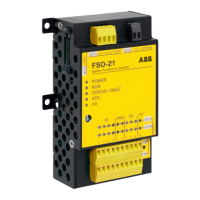68 Safety functions
STO function
The operation of the STO function when the SBC is not used is described in the time
diagrams and tables below. For configuration, see section How to configure STO on
page 331.
Without an encoder
A Time to zero speed (parameter STO.14): Time from the STO activation to the moment
when the safety function is completed and the STO completed indication (parameter
STO.22) goes on. You must set this to the estimated time in which the motor coasts to a
stop from the maximum speed.
B Restart delay after STO (parameter STO.13): Time from the STO activation to the
moment when the acknowledgment becomes allowed. With this parameter, you can
allow a restart of the drive before the motor has stopped (fly-start). You can use this
feature only in certain applications. This parameter is relevant only when an external
request activates the STO function.
Step Description
1 The STO request is received (for example, from the I/O). The FSO activates the drive
STO function and starts counters for times A and B. STO active indication parameter
STO output (STO.21) goes on.
2 After time B has elapsed, the acknowledgement becomes allowed as soon as the
STO request has been removed (step 4).
Note: If an SSE or SS1 request is received while the STO function is active, the STO
function must be completed before the acknowledgement is allowed.
3 After time A has elapsed, the FSO module defines the motor as stopped and the STO
completed indication goes on.
4 The STO request is removed.
Drive STO state
& indication
4
STO request
Motor speed
Time
A
5
3
STO completed
indication
1
B
2
STO.14
STO.13

